#sustainable urban farming
Text
The World's Best Awards Urban Agriculture Company of 2024
Urbanization is rapidly reshaping landscapes in our world today. Thus, the importance of sustainable urban agriculture has never been more evident. Recognizing the pioneering efforts of companies at the forefront of this movement, The World’s Best Awards proudly presents the winners of the Urban Agriculture Company of 2024 title.
These winners are celebrated for their innovative approaches to…

View On WordPress
#city farming#sustainable urban agriculture#sustainable urban farming#The World&039;s Best#The World&039;s Best Awards 2024#The World&039;s Best Awards Urban Agriculture Company of 2024#The World&039;s Best Magazine#urban agri#urban agriculture#urban farming
0 notes
Text
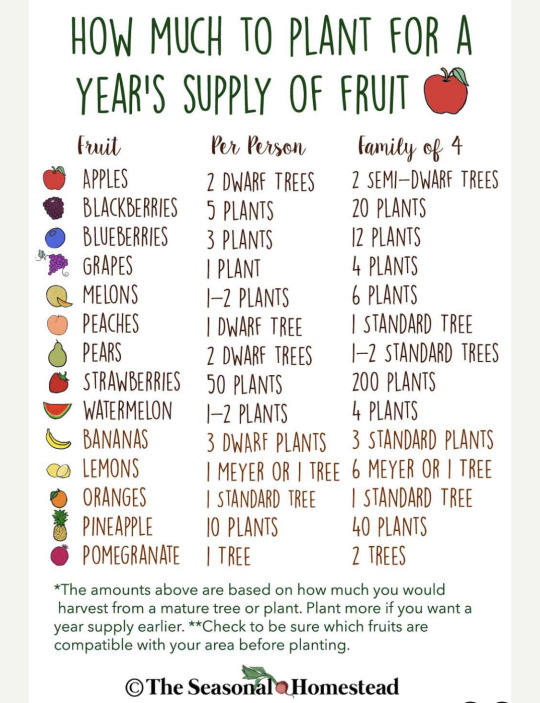
📸 The Seasonal Homestead
#homestead#garden#gardening#homesteading#self sufficient#self sustainable#urban farm#self sustainability#fruit#fruit trees#grow your own food
536 notes
·
View notes
Link
Recent research has begun to provide data on how well urban agriculture actually works if you’re planning to, you know, eat. A review paper published last month by researchers working on the Rurban Revolution project surveyed previous studies and determined that on average, urban agricultural yields (including both outdoor and indoor growing operations) were on par or higher than those of typical farms. But certain crops, like lettuces, tubers, and cucumbers, had yields up to four times higher when grown in cities. A separate team of scientists in Australia looked at 13 urban community farms for a year and found their yields to be twice that of typical commercial vegetable farms.
The caveat, though, is that this productivity comes in part from intensive human labor. On a commercial farm, crops are usually grown one at a time and tended with specialized equipment—you can’t plant wheat and carrots in the same field because they’re harvested in totally different ways. Crops also have to be spaced out to make room for where the equipment drives, reducing the amount of land that’s actually producing food.
An urban farm, by contrast, can grow all kinds of crops packed closely together because they’re harvested by hand. That’s part of the reason why Bousselot’s tiny rooftop garden in Denver is so productive. That crop diversity also means you can harvest different plants at different times—tomatoes in August, pumpkins in October—so the supply of food is more broadly distributed. Even though Bousselot has already harvested over 200 pounds of food, she still has two months left to go.
That requires human labor instead of a machine. So while urban farming can have a higher yield than traditional agriculture, it’s not necessarily as efficient. “But that inefficiency could easily change,” says Robert McDougall, an agricultural scientist at the independent research company Cesar Australia, who led the Australia study. “The people I studied were people who carried out urban farming mostly for recreational purposes, and so weren’t really interested in working as efficiently as possible. And they weren’t necessarily using the most efficient sources of materials.”
Take water, for example. Cities are currently designed to be impervious to rain, quickly draining it off streets to keep roads and buildings from flooding. But some urban areas are now transitioning into “sponge cities,” designed to safely soak up rain and store it for later use. In Los Angeles, for instance, officials are experimenting with roadside green spaces, where water seeps underground and into storage tanks. Rurbanized cities of the future could tap into that water source to grow food, and the gardens themselves could act like sponges, collecting rainwater to prevent local flooding.
Better municipal composting programs could also provide urban farmers with mulch so they don’t have to rely on synthetic fertilizers, which are terrible for the environment. “Were the gardeners I studied more tapped into these various sources of materials that were available within the environment around them,” says McDougall, “they could have easily carried out their farming in a much more sustainable fashion.”
Urban farms attract a host of pollinators like bees, McDougall has found. These insects, along with other pollinators like birds, could help boost biodiversity.
Cities also need all the green spaces they can get to counter the “urban heat island effect,” or the tendency for the built environment to absorb more of the sun’s energy than parks and forests do. Temperatures in urban areas can be 20 degrees Fahrenheit hotter than surrounding rural ones, where the plentiful vegetation releases water vapor—cooling the area as the plants essentially sweat. Bringing more plant life into cities will help cool things off and save lives during extreme heat events.
Urban agriculture can help insulate individual cities against food shocks, like if a particular mass-produced crop fails—which is increasingly likely as climate change spawns longer, more intense droughts. “You depend less on globalized supply chains,” says environmental scientist Florian Payen, who authored that review paper on yields. (He’s now at Scotland’s Rural College, but did the research while at Lancaster University.) “And so you are maybe less vulnerable to all of the different things like we’ve seen with Covid, or with climate change, that can impact the supply chain.”
[...]
In Denver, Bousselot is experimenting with solar panels to not only increase food security, but energy security as well. The idea, known as agrivoltaics, is to grow crops under rooftop solar panels that generate free, abundant energy for the building beneath them. The green roof also acts like insulation for the structure, reducing its cooling needs, while the partial shade the panels provide for the plants can significantly boost yields. (Too much sun is bad for certain crops. For example, other researchers have found that peppers produce three times as much fruit under solar panels than in full sun.) It’s also warmer up on a roof, and Bousselot has seen tomatoes grow faster, reaching harvest sooner.
Her Denver rooftop also seems to protect its crops from pathogenic fungi. “Up on the green roof, because of the high-wind, high-solar-radiation conditions, we have very, very little issue with that,” says Bousselot. “So I think there's a ton of potential for selecting crops that would produce even higher, potentially, on a rooftop compared to the same place on the ground.”
#urban farming#cities#farming#sustainability#Marx something something abolition town and country distinction#agrivoltaics#solarpunk
1K notes
·
View notes
Text
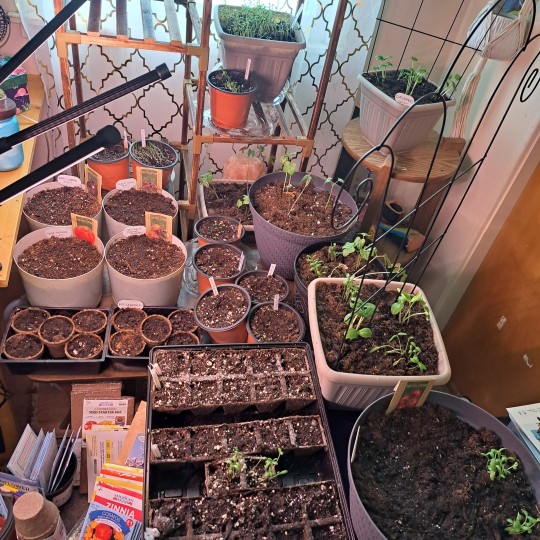

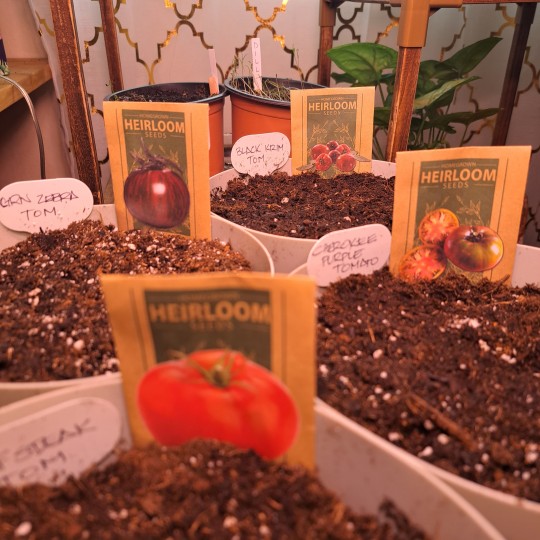


Ooooookaaaay Round 2! Transplanted all.of those morning glories that shot up into bigger pots.
Distributed Marigolds into Basil and tomato pots.
Got 8 cucumber shoots transplanted into their own pots.
Planted Hollyhock seeds and a varying variety of different tomato plants.
My craft room is over flowing!! I can't wait to get the greenhouse back up. Hopefully it will be done by April 15th!
#urban gardening#gardeners on tumblr#container gardening#urban farming#green thumb#gardenblr#cottagecore#greenblr#cottageblr#self sustainability#hollyhock#tomato plant#basil#dill#cilantro#marigolds#native wildflowers
41 notes
·
View notes
Text
Good afternoon everyone~
It's cold, windy and it's been raining on and off all day but I finally got out to harvesting the sweet potatoes.
I started with the 'L' bed.

This is the bowl I'll be using to collect the spuds for this deep raised bed.
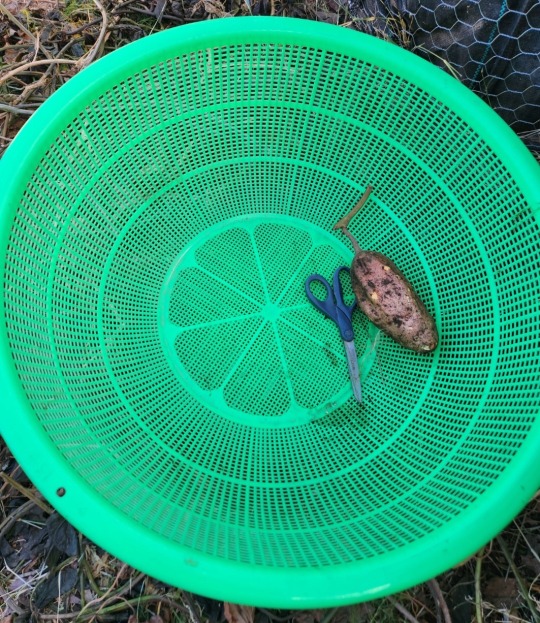
Those are full size scissors btw. This is the absolute biggest strainer I own and when I do harvesting I'm always glad to have it! Helps with carrying and washing off dirt outside so much easier!

It was pretty fun digging round for the spuds and to be honest the size and shape of some of them really suprised me!

For some size comparison, my hand is right on top of them.
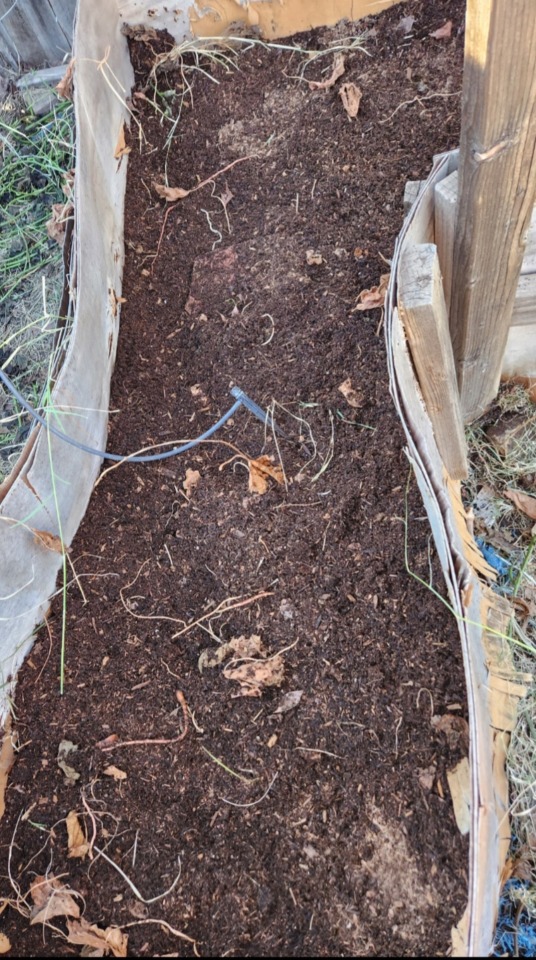
All cleaned out!
Next was the little round bed in the corner. I wasn't really expecting much, but it filled the bin pretty good.

I've washed the spuds off and am letting them dry off but I'll be finding a spot inside soemwhere to let them sit and cure for a bit of time. (I probably will let them cure until end of febuary.)
Curing your sweet potatoes is what makes them sweet, you can eat them right away but their said to be bitter. (I will be trying 1 potato to see if this is true!) Curing them should be done for at least 2 week in a cool dry space (around 80*f). If you under 80*f space add 7 more days.
I thought this was neat and wanted to share it. since I've not seen a sweet potato grown or dug up before

I wasn't expecting so much differance in spud size from one single root.
And one last pic,
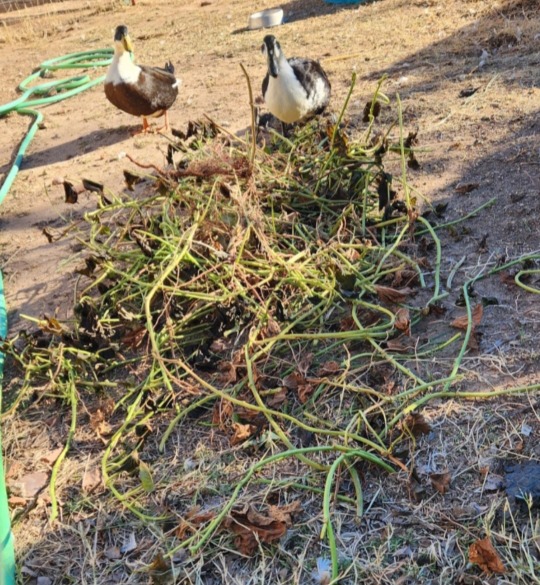
The ducks quite like the greens, while there's not much left of it I'm going to leave the vines a couple days so they can use it as enrichment/snack opportunity.
Weigh in on the spuds later!
🍠🌱Happy Homesteading and Harvesting!!
🌱🍠
1.11.2024
#self sufficient living#homesteading#thestudentfarmer#studentfarmer#self sufficiency#food#garden#gardening#low waste#duck#sustainability#smalls scale differences#urban animal keeping#urban biodiversity#urban homesteading#urban gardening#urban farming#grow what you can#simple plants to grow#multipurpose crops#right to grow#human right to clean food#right to grow food#raised garden beds#start to finish#will it grow?#food sovereignty#whole foods#first time growing#going green as can be
59 notes
·
View notes
Text
"In Washington D.C., a sophisticated sewage treatment plant is turning the capital’s waste into a form of capital: living capital that is fertilizing the gardens of farms of the Mid-Atlantic region and saving vast quantities of resources.
Described by the workers’ there as a “resource recovery plant,” D.C. Water run a biogas plant and high-quality fertilizer production in the course of their dirty duty to ensure the city’s waste finds a safe endpoint.
The nation’s capital is exceptional at producing waste from the toilet bowls of the 2.2 million people who live, work, and commute through the city and its suburbs.
Reporting by Lina Zeldovich reveals that rather than trucking it all to a landfill, D.C. Water extract an awful lot of value from the capital crap, by looking at it as a resource to send through the world’s largest advanced wastewater treatment plant, which uses a “thermal hydrolysis process” in which it is sterilized, broken down, and shipped off for processing into “Bloom,” a nitrogen-rich, slow-release fertilizer product.
The other “Black Gold”
At their facility in southwest Washington, huge aeration tanks percolate the poo of everyone from tourists to the President. After it’s all fed into enormous pressure cookers where, under the gravity of six earth atmospheres and 300°F, the vast black sludge is rendered harmless.
Next this “Black Gold,” as Zeldovich described it, is pumped into massive bacterial-rich tanks where microbes breakdown large molecules like fats, proteins, and carbs into smaller components, shrinking the overall tonnage of sewage to 450 tons per day down from 1,100 at the start of the process.
This mass-micro-munching also produces methane, which when fed into an onsite turbine, generates a whopping 10 megawatts of green energy which can power 8,000 nearby homes. [Note: Natural gas (which is mostly methane) is definitely greener than coal and oil, but it still causes a significant amount of emissions and greenhouse gases.] The 450 tons of remaining waste from the D.C. feces are sent into another room where conveyor belts ring out excess fluid before feeding it through large rollers which squash it into small congregate chunks.
D.C. Water sends this to another company called Homestead Gardens for drying, aging, and packaging before it’s sold as Bloom.
“I grow everything with it, squashes, tomatoes, eggplants,” Bill Brower, one of the plant’s engineers, tells Zeldovich. “Everything grows great and tastes great,” he adds.
“And I’m not the only one who thinks so. We’ve heard from a lot of people that they’ve got the best response they’ve ever seen from the plants. Particularly with leafy greens because that nitrogen boost does well with leafy plants. And the plants seem to have fewer diseases and fewer pests around—probably because Bloom helps build healthy soils.”
While farms around the country are facing nutrient depletion in soils from over-farming, turning to synthetic fertilizers to make up the difference, introducing more such thermal hydrolysis plants could truly revolutionize the way humans look at their feces—as a way of restoring the country’s soils rather than polluting them. As Mike Rowe would say, it only takes a person who’s willing to get their hands dirty."
-via Good News Network, November 23, 2021
Note: You can buy this fertilizer yourself here!
#older news but still relevant#you can go buy this fertilizer yourself!#sewage#sanitation#fertilizer#sustainability#circular economy#sustainable agricuture#nitrogen#waste#waste management#waste disposal#good news#hope#hope posting#washington dc#dc#united states#district of columbia#urban farming#solarpunk#urban gardening#environmentalism#farming#rooftop garden#gardening#edible gardening#toilet#soil#soil quality
128 notes
·
View notes
Text
~Welcome to the May Garden~
People say that April showers bring May flowers. I can definitely say that this year, those people were right!

My roses and pansies are bursting with colors and blooms. Soon the daily deadheadings will begin to keep these lovely flowers blooming all season.


I also planted some begonias this year and my mini carnations lived through the winter to see another spring.

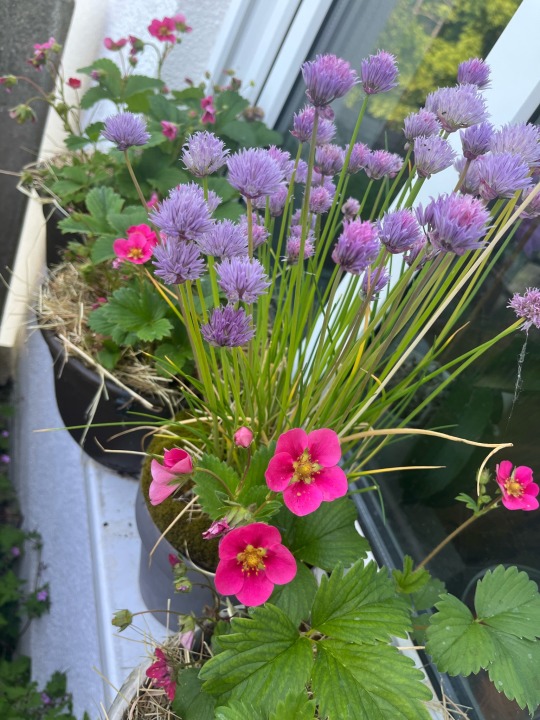
On the fruit side of things, my blackberry bush has gone nuts and has so many flowers that the pollinators are just loving. The strawberries are flowering as well and soon I’ll have to put a net over them since the birds have now realized that there’s free food on our balcony…

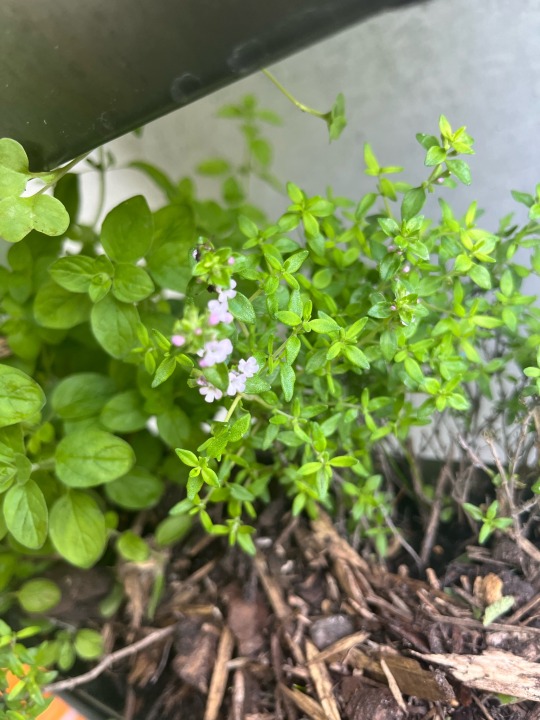
My peppers are also beginning to flower in the greenhouse. If each bloom or even a half of the blooms actually produce peppers I will be jumping for joy come harvest time! The thyme is also flowering, which is a big win for me as we lost half of the plant during winter. To see that it has come back and is thriving really brings a smile to my face every time I walk outside. She’s a fighter 💪🏻
Well, that’s all for this month. In between now and the June update I hope we have lots to harvest from the spring veggies to make room for all the summer and fall goodness!
Until next time,
~ L
#spring#cottagecore#farmcore#gardening#balcony garden#urban farming#grandmacore#homesteading#vegetables#homestead#spring time#sustainability
15 notes
·
View notes
Note
10, 12, 36 :)
10. are you good at hiding your feelings?
yes and no. Like it takes a lot of effort to properly hide my feelings, and I’m generally quite transparent, like if your views are bigoted in my eyes you’ll probably see it on my face. I can mask that if I need to, but it’s too much effort and too much of a rift between me and the world to do most times. But the extent of my feelings? All the time. I barely know how not to. I’m not dramatic generally, I’m a woman of colour as well so that statistically adds to the ‘okay’ farce I have to put on, and generally I don’t feel safe being fully honest because I don’t trust people to have proper boundaries and not take it on. So if I’m honest, like really honest, of what I’m only now discovering (turns out even mental health professionals aren’t good at seeing when you’re downplaying things) that means I really trust you.
12. what is something you want right now?
just good public transport honestly. I want to design it with no effort and have it installed immediately without the pesky roadworks stage
36. 3 dreams you want to fulfil
just looking in the dreams diary my friend got me for my 16th right now! I’ll put them in order here
I really want to solve world hunger. Like in a systemic, sustainable, kinder to animals than we are now, way. It sounds silly and can’t be done alone, but a big part of me fully believes I’ve got the skill and connection to work up to it and if I don’t, I can simply work at it over decades
design a fully sustainable city by 2040. That one’s doable. As to whether anyone will build my city, I’ll need a lot more hands than my own
this dream journal really isn’t useful. I should fill it in more, I’ve mostly put in here things I’ve already done and some that are just weird so I’ll say one of the weird ones: create an inclusive but intimate family unit. Don’t ask me what 16yo me meant, but to me this is a lot more about chosen family, but it’s also putting in practice all I’ve done to learn how to parent all kinds of neurodivergent kids (I use it on myself and other adults mostly). Like I think the core of the dream is I really want to show that it’s doable to create an environment where no matter how different or difficult (in the eyes of the majority) you are to connect/communicate with everyone is lovable in practice as well as in theory. And as always this includes trauma related neurodivergences and pd’s—be it chosen family, my own biological kids, or some combination of it.
#neurodivergent liberation#sustainable transport#urban design#urban farming#personal mental health tag#(All the things your amazing questions apply to!)
5 notes
·
View notes
Text

Because knowledge is power
#vikings#heathen#palidin#templar#warriormindset#warrior of light#thinblueline#modern templar#hillbilly#country living#country#east tennessee#tennessee#texans#westtexas#self sufficient living#self sustainable#preparedness#urban nature#urban farming#red neck#zombie hunter#hunter gatherer#yield farming#farmlife
7 notes
·
View notes
Text
Garden Therapy
After a few hours of scrolling on Twitter yesterday, I was feeling dark, hopeless, and sad. Another school shooting. 21 dead. My youngest son graduates from high school tomorrow and I should be happy, we should all be so happy, but instead all I can picture is all of the parents across the country, who had planned to see their children graduate someday, counted on it, took it for granted even,…

View On WordPress
#beginner#container garden#cottagecore#dark times#darkest timeline#gardencore#Gardening#ghetto garden#green thumb#inspiration#Journal#landscaping#nature lover#nature therapy#photography#self sustainability#sustainability#therapeutic#urban farming#urban gardening#wyoming
16 notes
·
View notes
Text

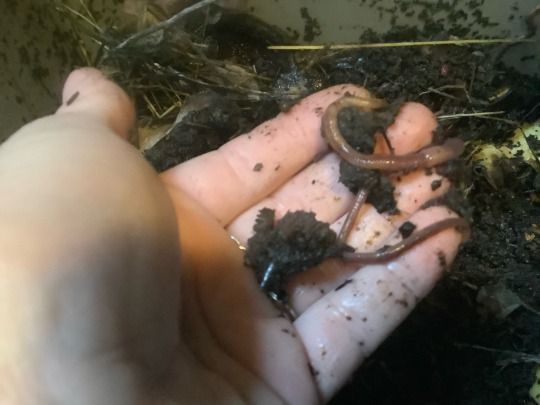
These are my red compost worms i’ve had about a year and half. After about six months i would say i got more familiar with the consistency of wet/dry/ grit/food ratios they needed (its a thang). We keep this vented container in our laundry room. The casings are great fertilizer, and rival the compost pile. 🪱
#vermaculture#lasteveharvesting#permaculture#organic#green#veganfood#live simply#farming#deep ecology#primitive#natural farming#worms#earthy#urban homesteading#scraps#sustainableliving#sustainability#prepper
4 notes
·
View notes
Text
Which way does your garden face?
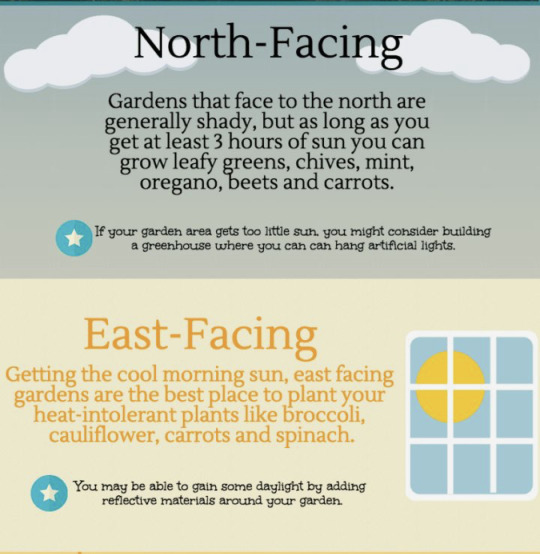

Ref: Youshouldgrow.com
#homestead#garden#gardening#homesteading#self sufficient#self sustainable#urban farm#self sustainability
154 notes
·
View notes
Text
Help I got drunk then spent 1hr explaining to my architect friend how I’m going to develop a plot of land my parents own if they don’t disown me for being gay.
#sustainable living; high quality construction#micro farm shared between 3 houses on the same plot of land#*chefs kiss* of living#I know an architect; an urban planner I just need a *shudder* geotechnical engineer#I’ll have enough savings in like 5yrs
3 notes
·
View notes
Text
Revolutionize Your Home with the Ultimate Smart Indoor Gardening System

In today's fast-paced world, where technology continues to infiltrate every aspect of our lives, it's no surprise that even gardening has gone smart. Imagine a home where lush greenery thrives effortlessly, where herbs and vegetables grow bountifully year-round, all managed with the touch of a button.
Gone are the days of traditional gardening methods fraught with guesswork and uncertainty. The Smart Indoor Gardening System integrates cutting-edge technology to streamline the entire gardening process, from seed to harvest. Whether you're a seasoned gardener or a novice, this system empowers you to cultivate thriving plants with minimal effort.
One of the key features of the Smart Indoor Gardening System is its intuitive automation capabilities. Equipped with sensors that monitor factors such as moisture levels, temperature, and light intensity, the system autonomously adjusts environmental conditions to ensure optimal growth for your plants. Say goodbye to the hassle of manual watering schedules and fretting over whether your plants are receiving adequate sunlight.
Get More Insights On This Topic: Smart Indoor Gardening System
#Smart Indoor Gardening System#Indoor Farming#Hydroponics#Vertical Farming#IoT Agriculture#Automated Gardening#Sustainable Agriculture#Urban Agriculture
0 notes
Text
It's that time of year again!! I have started a few baby plants in my craft room!!
I live in Wyoming, so there will DEFINITELY be at least one more snow storm before spring, so I have to start inside.
I decided I wanted to do mostly flowers to start, Morning Glories, Dandelions, and Marigolds.
I originally went into my gardening adventures HATING Morning Glory flowers, but since I have seen how durable, and climby, and colorful they are, I love them so hard!!! They are now my go to for easy-peasy pops of color all over my yard!
The Dandelions are for tea, and the Marigolds are for pest control.

Morning Glories go hard. They are always my first and most successful flower. Love them!
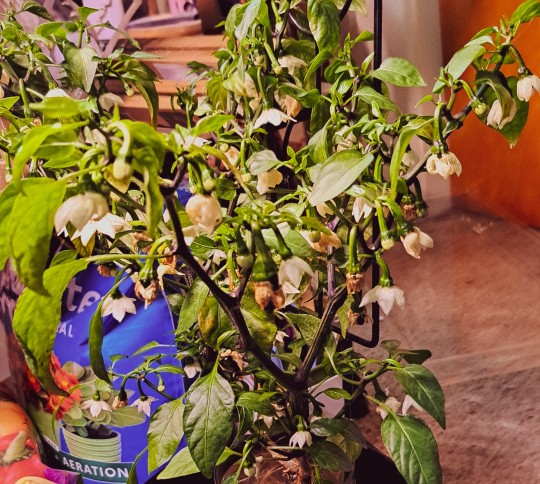

Also have a Jalapeno plant going and some Cucumbers.
Not pictured (because they have not sprouted, so its just dirt pics so far), but planted the same day: Chives, Basil, Rosemary, Dill, Chamomile, Mixed Peppers, Green Peppers, Serrano Chilis, and micro-greens.
I feel like I'm coming awake from a long nap and it's time to get going!!!
#urban gardening#gardeners on tumblr#container gardening#urban farming#green thumb#gardenblr#self sustaining#cottageblr#cottagecore#greenblr#green witch#flora
14 notes
·
View notes
Text
Kitchen post today~
With prices being what they are I like a good deal on groceries when I can find it. Sometimes that leads me to buying large quantities of things.
This week the local scratch n dent market had 5 pound bags of golden potatos on sale, 2 for $4. We like potatos so I snagged a few bags. Since i had 2 from last week's groceries I decided to pick through them all.
I tossed a few rotten ones and sorted out the good from the ones getting on the going side. The good ones I put up in a storage tote (a cooking pot for now) for later cooking.
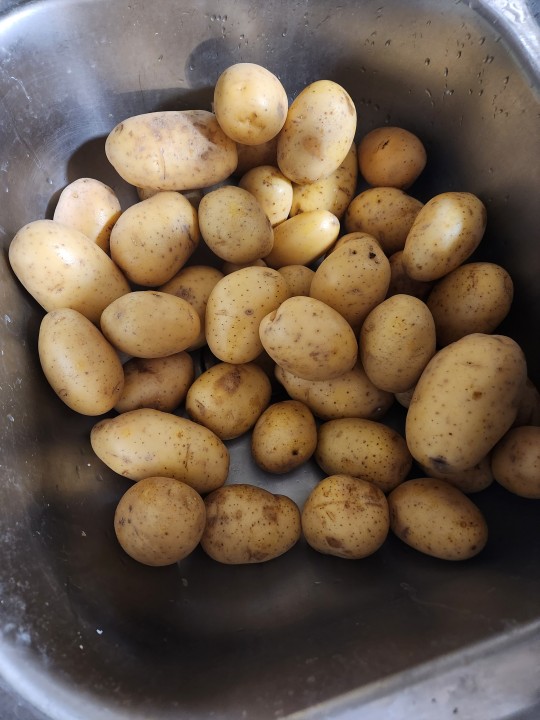
These ones are the contenders for the weekly meal/freezer prep. They had some funny or funky spots, things that can be cut off and thrown away or in the compost. I clean them after washing them well.
As a heads up, it's not suggested to feed chickens raw potatoes. So leave anything with raw potato bits in the trash or the compost bin.
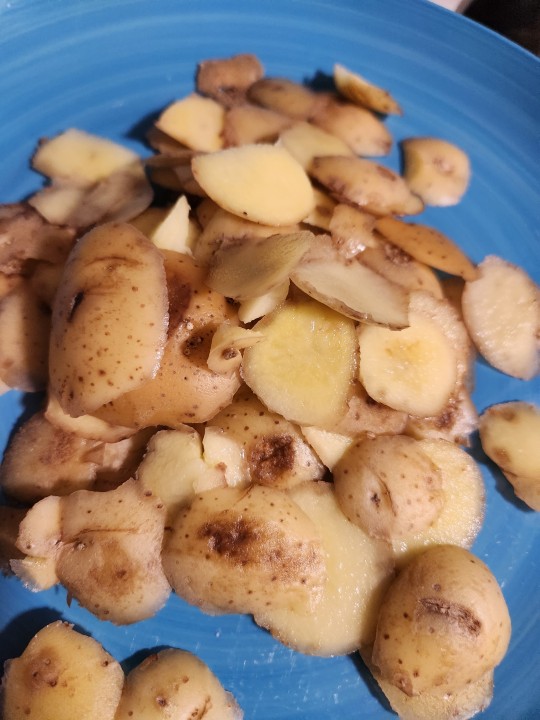
The bad bits.
If you feel need to you can wash them up again. I move to peeling after words.
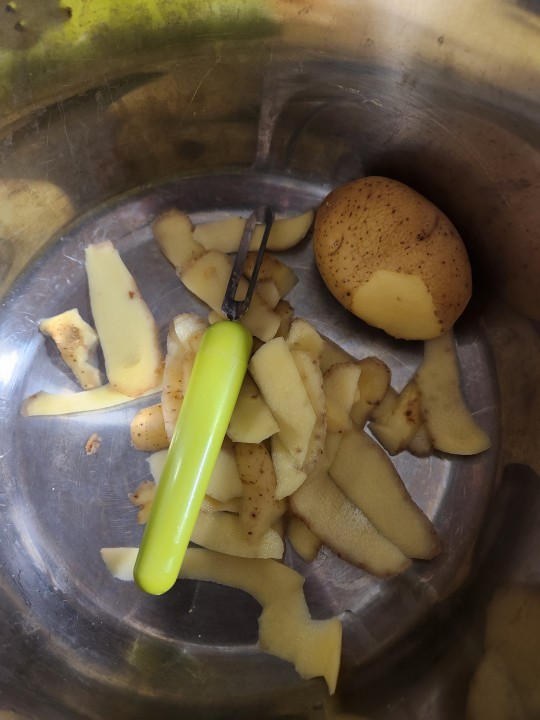
I save the peels for breakfast potatoes, or to make soup.
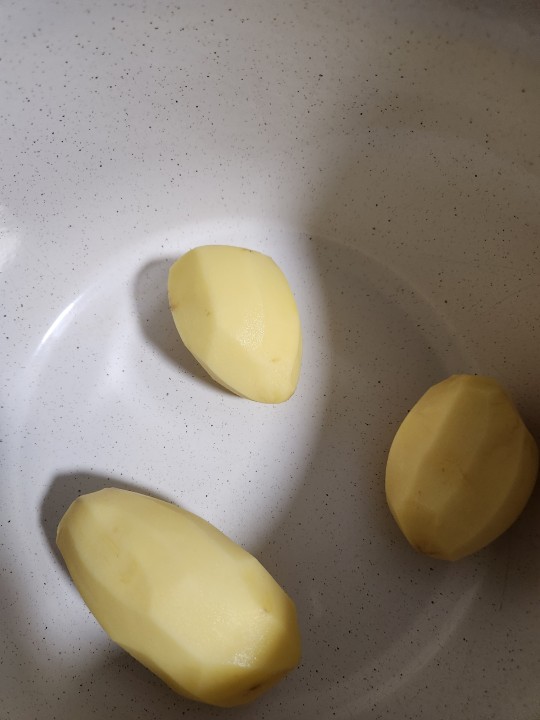
A few peeled spuds.
Afterwords, depending on how many potatoes needed to be processed will decide what im making. This time I had enough potatoes to do cubed potatoes and hashbrown potatoes.
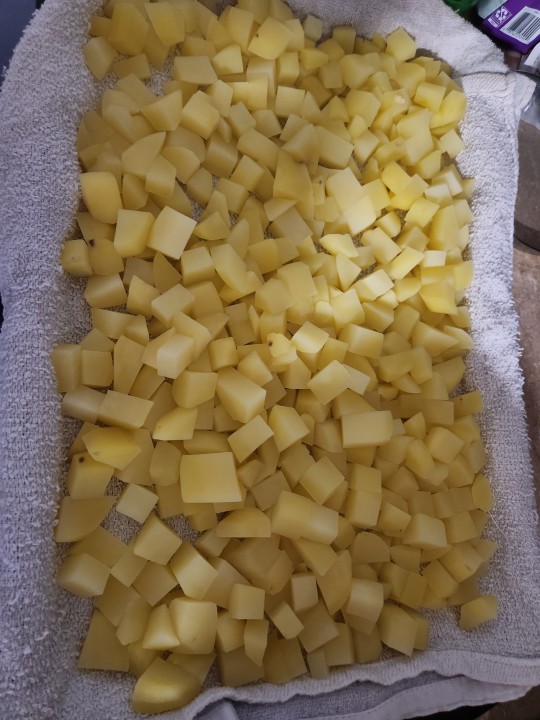
Cube potatoes, then blanch them till all Dante in a pot. (Not quite to mash potatoes softness, but not crunchy.)
Drain, cool quickly. (If your into water conservation, save the water for your plants once cooled) I cool till just under warm and lay them out to drain/dry a bit.
Then take a pan and lay out a clean kitchen towel on it. Pour dry potatoes on and place in freezer till frozen.
Store in container and use like regular frozen potatoes.
Moving to hashed potatoes
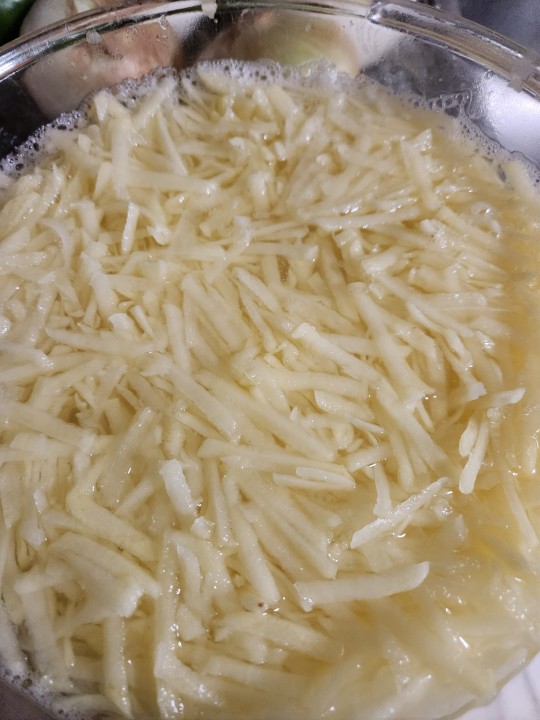
Similar to the cubed potatoes except I grated them.
I like to destarch my potatoes a little so I do a soak for about an hour, drain and then blanch.
I did about 5 minutes to blanch the hash, every couple minutes fish out a peice and test it to see if it's crunchy or just firm. Drain, cool asap.
Lay out to drain and dry a bit.
Lay towel on baking sheet. Place drained hashed potatoes on top. Place in freezer and freeze a few hours.
When frozen package up. Date and use as necessary :)
Other potato freezing/preserving resources
https://www.bbcgoodfood.com/howto/guide/how-to-freeze-potatoes
https://www.motherearthnews.com/real-food/dehydrate-potatoes-for-various-uses-zbcz1507/
🥔🌱Happy Homesteading!🌱🥔
#homesteading#self sufficient living#thestudentfarmer#studentfarmer#self sufficiency#food#garden#gardening#low waste#potato#sustainability#kitchen economics#resources#kitchen#food preservation#preserving freezer#preserving potato#simple eating#urban homesteading#urban farming#rooter to tooter#tip to tail#snout to tail#scrap cooking#budget cooking#small scale solutions
98 notes
·
View notes